
A bolete is a type of mushroom, or fungal fruiting body. It can be identified thanks to a unique cap. On the underside of the cap there is usually a spongy surface with pores, instead of the gills typical of mushrooms. A similar pore surface is found in polypores, but these species generally have a different physical structure from boletes, and have different microscopic characteristics than boletes. Many polypores have much firmer, often woody, flesh.
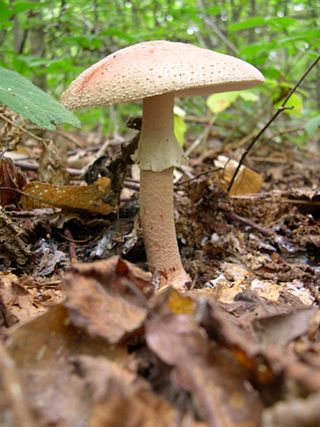
The blusher is the common name for several closely related species of the genus Amanita. A. rubescens, or the blushing amanita, is found in Europe and Asia, and A. novinupta, also known as the new bride blushing amanita or blushing bride. is found in western North America. Both their scientific and common names are derived from the propensity of their flesh to turn pink upon bruising or cutting.
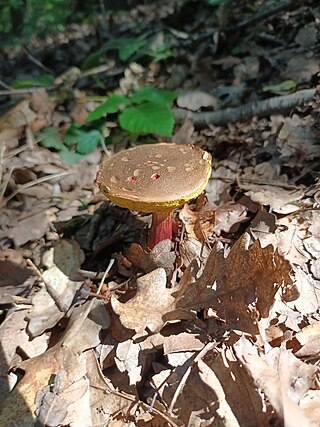
Xerocomellus chrysenteron, formerly known as Boletus chrysenteron or Xerocomus chrysenteron, is a small, edible, wild mushroom in the family Boletaceae. These mushrooms have tubes and pores instead of gills beneath their caps. It is commonly known as the red cracking bolete.

Boletus barrowsii, also known in English as the white king bolete after its pale colored cap, is an edible and highly regarded fungus in the genus Boletus that inhabits western North America. Found under ponderosa pine and live oak in autumn, it was considered a color variant of the similarly edible B. edulis for many years.

Hortiboletus rubellus, commonly known as the ruby bolete, is a small, dainty, brightly coloured member of the family Boletaceae, with a reddish cap and stipe, and yellow pores. Like many boletes, it stains blue when cut or bruised. It is found in deciduous woodland in autumn. There is some question over its edibility, and it is reportedly of poor quality with a taste of soap. Until 2015, the species was known as Boletus rubellus.

Xerocomus subtomentosus, commonly known as suede bolete, brown and yellow bolete , boring brown bolete or yellow-cracked bolete, is a species of bolete fungus in the family Boletaceae. The fungus was initially described by Carl Linnaeus in 1753 and known for many years as Boletus subtomentosus. It is edible, though not as highly regarded as other bolete mushrooms.
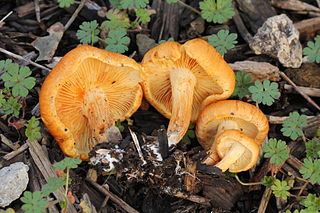
Gymnopilus aurantiophyllus is a species of mushroom-forming saprotrophic fungus in the family Hymenogastraceae.

Butyriboletus appendiculatus is an edible pored mushroom that grows under oaks and other broad leaved trees such as beech. It is commonly known as the butter bolete. It often grows in large colonies beneath the oak trees, and is frequently found cohabiting with old oaks in ancient woodland. It is relatively rare in Britain. Its stipe and pores are often bright yellow and its flesh stains bright blue when cut or bruised.

Xerocomellus zelleri, commonly known as Zeller's bolete, is an edible species of mushroom in the family Boletaceae. First described scientifically by American mycologist William Alphonso Murrill in 1912, the species has been juggled by various authors to several genera, including Boletus, Boletellus, and Xerocomus. Found solely in western North America from British Columbia south to Mexico, the fruit bodies are distinguished by their dark reddish brown to nearly black caps with uneven surfaces, the yellow pores on the underside of the caps, and the red-streaked yellow stems. The fungus grows in summer and autumn on the ground, often in Douglas fir forests or on their margins. The development of the fruit bodies is gymnocarpic, meaning that the hymenium appears and develops to maturity in an exposed state, not enclosed by any protective membrane.
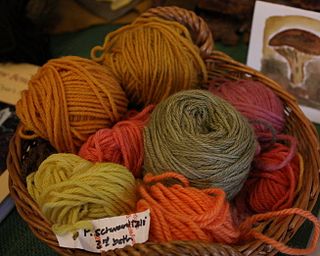
Mushrooms can be used to create color dyes via color-extraction with a solvent as well as particulation of raw material. The shingled hedgehog mushroom and related species contain blue-green pigments, which are used for dyeing wool in Norway. The fruiting body of Hydnellum peckii can be used to produce a beige color when no mordant is used, and shades of blue or green depending on the mordant added. Phaeolus schweinitzii produces green, yellow, gold, or brown colors, depending on the material dyed and the mordant used.

Xerocomellus is a genus of fungi in the family Boletaceae. The genus, as it was described in 2008, contained 12 species. However X. rubellus and X. engelii were transferred to the new genus Hortiboletus and X. armeniacus was transferred to the new genus Rheubarbariboletus in 2015. Molecular analysis supports the distinction of Xerocomellus species from Boletus and Xerocomus, within which these species were formerly contained. Xerocomellus in fact is only distantly related to Xerocomus and is most closely related to Tylopilus, Boletus sensu stricto, Porphyrellus, Strobilomyces, and Xanthoconium.

Amanita augusta, commonly known as the western yellow-veil or western yellow-veiled amanita, is a small tannish-brown mushroom with cap colors bright yellow to dark brown and various combinations of the two colors. The mushroom is often recognizable by the fragmented yellow remnants of the universal veil. This mushroom grows year-round in the Pacific Northwest but fruiting tends to occur in late fall to mid-winter. The fungus grows in an ectomycorrhizal relationship with hardwoods and conifers often in mixed woodlands.
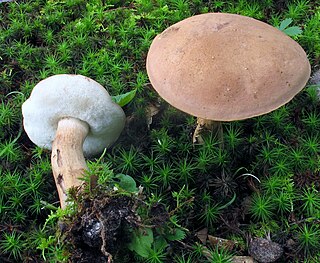
Porphyrellus indecisus, commonly known as the indecisive bolete, is a species of bolete fungus in the family Boletaceae native to North America. It was described in 1888 by Charles Horton Peck.

Cantharellus roseocanus, commonly known as the rainbow chanterelle, is a species of fungus in the family Cantharellaceae. Found in the Pacific Northwest region of North America, it was originally described in 1997 as a variety of Cantharellus cibarius, and later promoted to distinct species status in 2012.

Hygrophorus chrysodon, commonly known as the flaky waxy cap, or gold flecked woodwax is a species of fungus in the genus Hygrophorus. It is edible but bland in taste. The species is found throughout the Northern Hemisphere.

Aureoboletus flaviporus, commonly known as the viscid bolete, is a species of bolete fungus found in western North America, where it grows in ectomycorrhizal association with coast live oak, madrone, manzanita, and possibly with tanoak. In California, this mushroom appears during the rainy season in locations south of Mendocino County. This mushroom is "fairly common" but does not appear in large groupings, only as one-offs or small clusters in scattered locations.

Hygrocybe laetissima, also known as the cherry-red waxy cap, is a species of gilled mushroom found in North America. It appears to flourish in association with redwood forests. The authors of Mushrooms of the Redwood Coast note that this waxy cap is superficially similar to other waxy caps, including Hygrocybe splendidissima, Hygrocybe punicea, Hygrocybe aurantiosplendens, and Hygrocybe marchii. It also overlaps somewhat in range and appearance with Hygrocybe coccinea. This one has the coloration of a Rainier cherry. Not recommended as an edible mushroom because close cousins have made people sick. This mushroom species was first described by Alexander H. Smith and L. R. Hesler.
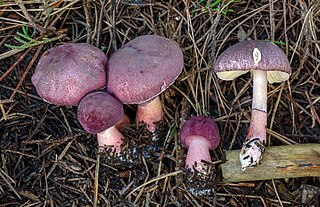
Lepiota decorata, also known as the pink parasol, is an uncommon species of gilled mushroom found in North America. The cap of L. decorata usually has a speckled violet pattern, stains orange when scratched, and is about 4 to 8 cm in diameter.

Caloboletus marshii, commonly known as Ben's bitter bolete, is a species of mushroom in the family Boletaceae. It is not poisonous, but it is too bitter to eat. It turns blue when cut or bruised, and it grows under live oak.

Caloboletus conifericola, commonly known as the dark bitter bolete, is a species of mushroom in the family Boletaceae. It is found in the Pacific Northwest.




















